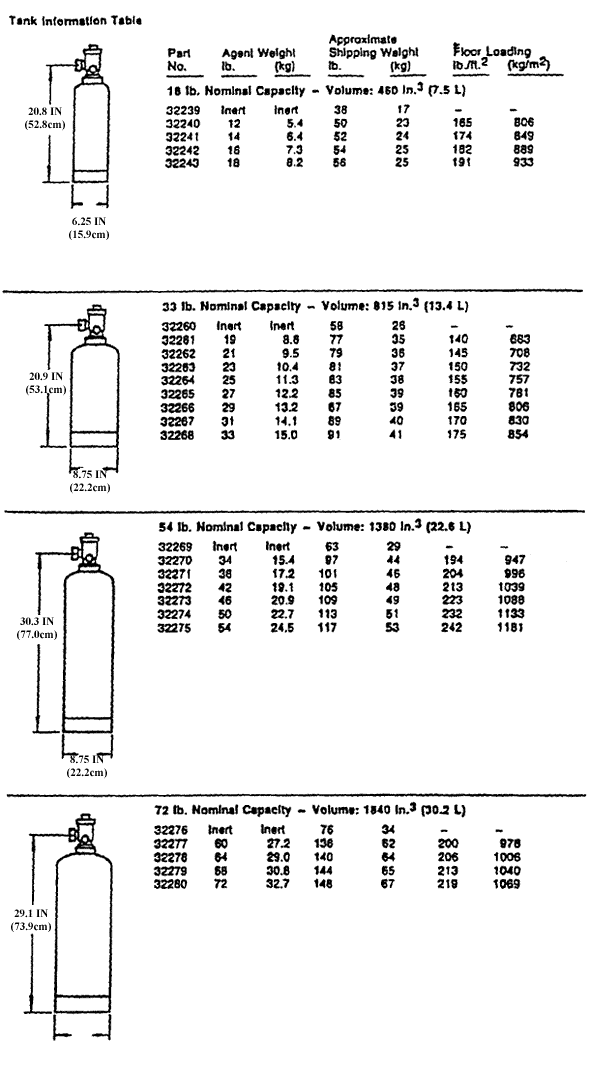
Appendix A: Manufacturer Specifications and Instructions
Contents
|
Manufacturer |
Valve Type |
System Pressure psi |
Agent Weight, lbs |
Part Number |
Valve Assembly Size, inches |
Page Number in Appendix A |
|
Ansul Halon 1301 System Containers |
A-3 | |||||
|
Ansul |
High Flow Valve |
360 |
18, 33, 54, 72, 90 |
32602 |
1 |
A-7 |
|
Ansul |
High Flow Valve |
360 |
90, 186, 340, |
32603 |
2 |
A-7 |
|
Ansul |
High Flow Valve |
360 |
600 |
57980 |
3 |
A-7 |
|
Ansul |
High Flow Valve |
360 |
600 |
76114 (replaces 57980) |
3 |
A-7 |
|
Ansul |
Pressure Differential Valve |
360 |
18, 33, 54,72,90,1, 86 |
26850 |
|
A-11 |
|
Ansul |
Cutter Type |
360 |
18, 54, 72, 90, |
16588 |
|
A-13 |
|
Ansul |
US Navy Valves |
600 |
10, 15, 60, 95, 125 |
77654N and others |
1, 1.5 |
A-16 |
|
Chemetron |
Alpha Series- Group 1 |
360 |
|
1-048-0720 V |
|
A-24 |
|
Chemetron |
Alpha Series- |
360 |
9 to 15 |
1-048-0819 H |
|
A-24 |
|
Chemetron |
Alpha Series- Group 2 |
360 |
|
1-048-0721 V |
|
A-24 |
|
Chemetron |
Alpha Series- |
360 |
16 to 26 |
1-048-0820 H |
|
A-24 |
|
Chemetron |
Alpha Series- Group 3 |
360 |
|
1-048-0722 V |
|
A-24 |
|
Chemetron |
Alpha Series- |
360 |
27 to 36 |
1-048-0821 H |
|
A-24 |
|
Chemetron |
Beta Series- Group 1 |
360 |
|
1-048-0723 V |
|
A-28 |
|
Chemetron |
Beta Series |
360 |
55 to 95 |
1-048-0822 H |
|
A-28 |
|
Chemetron |
Beta Series Group 2 |
360 |
|
1-048-0724 V |
|
A-28 |
|
Chemetron |
Beta Series |
360 |
96 to 167 |
1-048-0823 H |
|
A-28 |
|
Chemetron |
Gamma Series-Group 1 (250SB) |
360 |
153 to 268 |
1-048-0726 |
|
A-32 |
|
Chemetron |
Gamma Series-Group 2 (400B) |
360 |
237 to 415 |
1-048-0583 |
|
A-32 |
|
Chemetron |
Gamma Series-Group 3 (550B) |
360 |
314 to 550 |
1-048-0840 |
|
A-32 |
|
Chemetron |
High Flow - 600 |
360 |
|
1-061-0720 |
|
A-36 |
|
Chemetron |
Series 70 |
600 |
|
1-061-0730 |
|
A-52 |
|
Chemetron |
High Flow-360 |
360 |
|
1-061-0934 |
|
A-65 |
|
Kidde-Fenwal Halon 1310 System Containers |
A-82 | |||||
|
Fenwal |
Fill charge for HRD Sphere |
360 |
8 to 201 |
06-116300-001 |
|
A-85 |
|
Fenwal |
Spherical Modular Storage container |
|
|
|
|
A-87 |
|
Fenwal |
Cylinder Valve (Old style) |
360 |
|
31-19203X-XXX |
|
A-89 |
|
Kidde-Halon 1310 System Containers |
A-94 | |||||
|
Kidde |
Series 487 Commercial Valves |
360 |
10 to 125 |
486324 |
1.5 |
A-104 |
|
Kidde |
Series 487 Commercial Valves |
360 |
200 to 350 |
486363 |
2 |
A-104 |
|
Kidde |
Series 487 Commercial Valves |
360 |
600 |
486377 |
2.5 |
A-104 |
|
Kidde |
Obsolete Commercial Valves |
360 |
20, 40, 60, 125, 200, 312, 550 |
896150 |
|
A-106 |
|
Kidde |
Military Application Valve |
360 |
|
149743 |
|
A-110 |
|
Kidde |
US Navy Valve (Old Style) |
600 |
10, 15,60,95,125 |
486143 |
|
A-112 |
|
Kidde |
US Navy Valve (Old Style) |
600 |
10,15,60,95,125 |
898496 |
|
A-115 |
|
Kidde |
US Navy Valve (Obsolete) |
600 |
20, 40, 60, 95, 125 |
877653 |
|
A-120 |
|
Kidde |
US Navy Valve (Obsolete) |
600 |
20, 40, 60, 95, 125 |
840253 |
|
A-120 |
|
Fike |
See Appendix |
|
|
|
|
A-124 |
|
Ginge Kerr |
See Appendix |
|
|
|
|
A-137 |
|
Pyrotronics |
Series H- 8 |
360 |
4 to 8 |
|
|
A-145 |
|
Pyrotronics |
Series H- 15 |
360 |
9 to 15 |
|
|
A-145 |
|
Pyrotronics |
Series H- 30 |
360 |
20 to 30 |
|
|
A-145 |
|
Pyrotronics |
Series H- 60 |
360 |
35 to 60 |
|
|
A-145 |
|
Pyrotronics |
Series H-125 |
360 |
65 to 125 |
|
|
A-145 |
|
Pyrotronics |
Series H-250 |
360 |
130 to 250 |
|
|
A-145 |
|
Pyrotronics |
Series H-350 |
360 |
255 to 350 |
|
|
A-145 |
|
Wormald Int. |
Electric Valve Actuator |
360, 600 |
|
303426 |
|
A-156 |
|
Wormald Int. |
1" NGT |
360, 600 |
|
302936 |
|
A-160 |
|
Wormald Int. |
Multiple Stack Actuator |
360, 600 |
|
303444 |
|
A-163 |
|
Wormald Int. |
MK I, II, III, IV, V, and High Flow |
|
|
|
|
A166 |
ANSUL FIRE
PROTECTION
HALON 1301 SYSTEM CONTAINERS

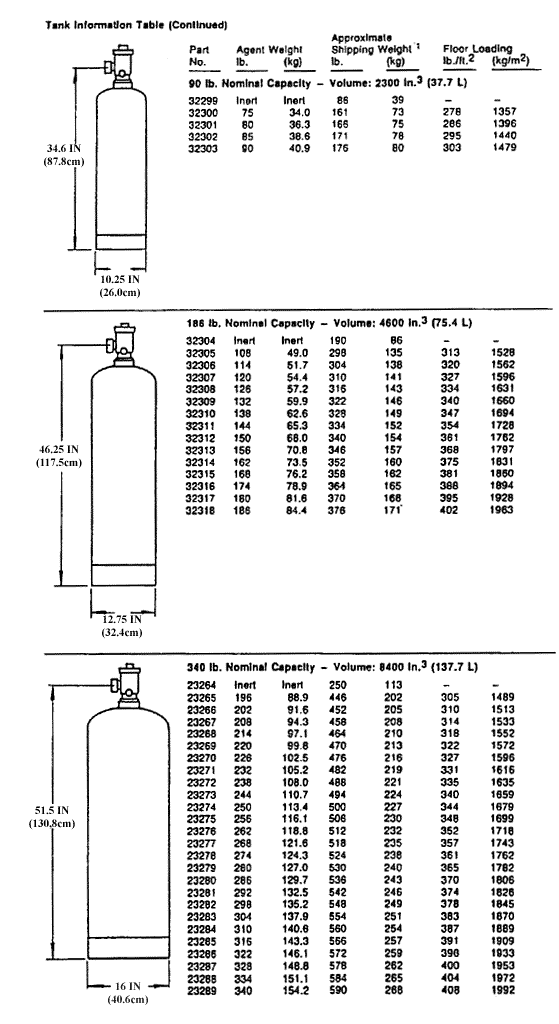
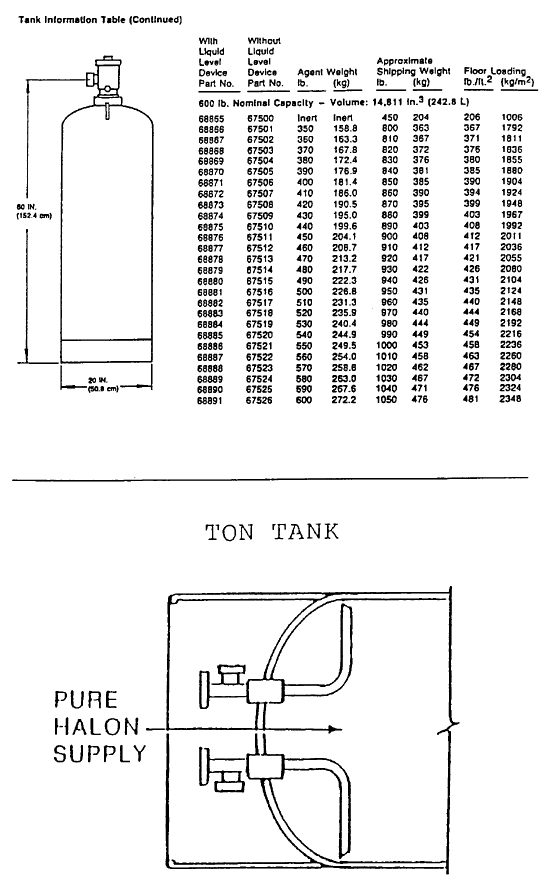
(Reference Field Fill Station Operation Manual P/N 30627)
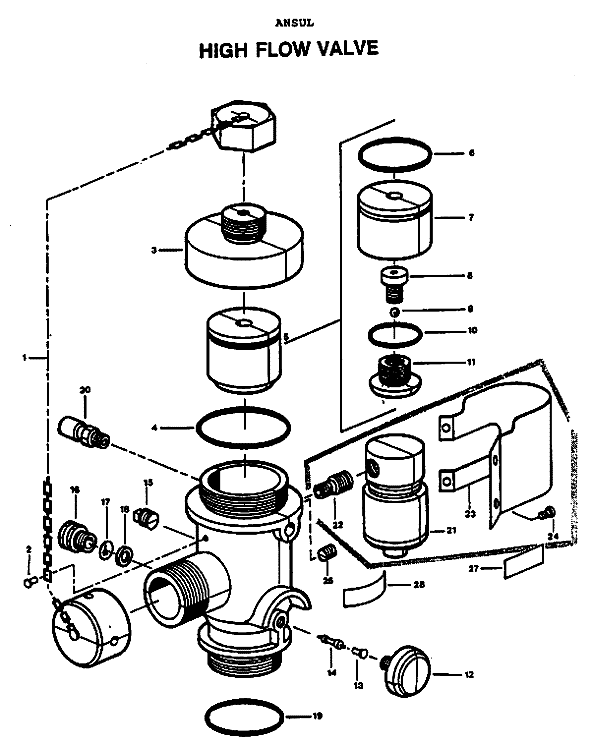
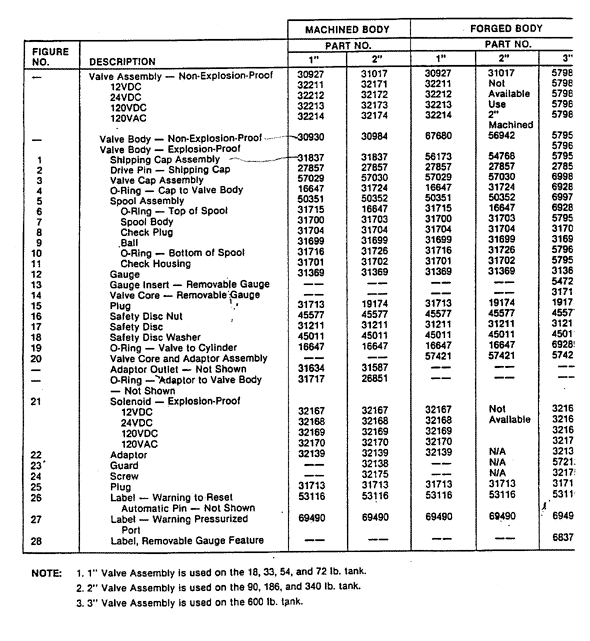
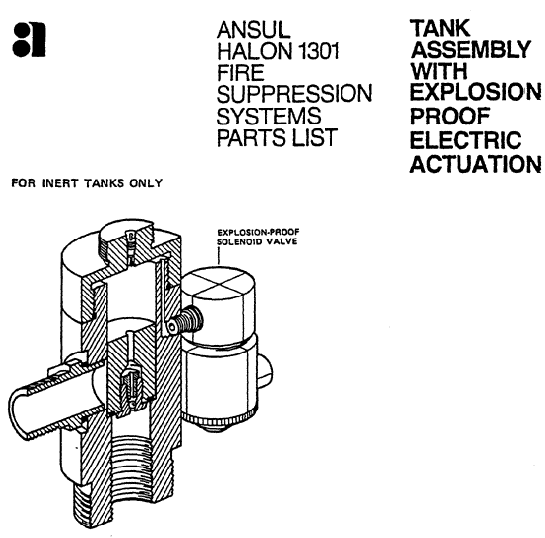
|
INERT TANK |
PART NUMBER | |||
|
12 VDC |
24 VDC |
120 VDC |
120 VDC | |
|
18 |
22627 |
22632 |
22637 |
22642 |
NOTE: For Part Numbers of variable filled tanks with explosion-proof electric
actuation, refer to Page(s) 5 and 6 of
Installation Manual (Part No. 32850)
of Data Sheet (Form No. F-77171).
ANSUL PRESSURE DIFFERENTIAL VALVE OPERATING PROCEDURES
(Reference Field Fill Station Operation Manual P/N 30627)
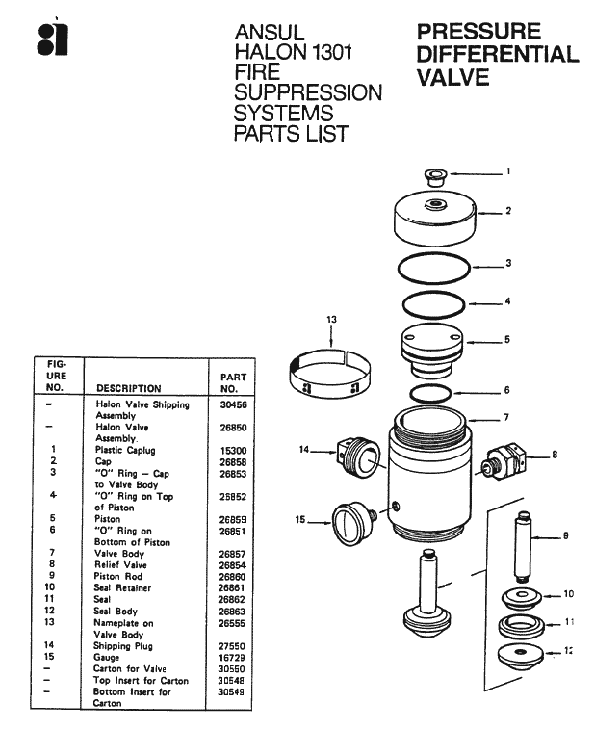
Form No.F-77207
ANSUL CUTTER TYPE ASSEMBLY OPERATING PROCEDURES
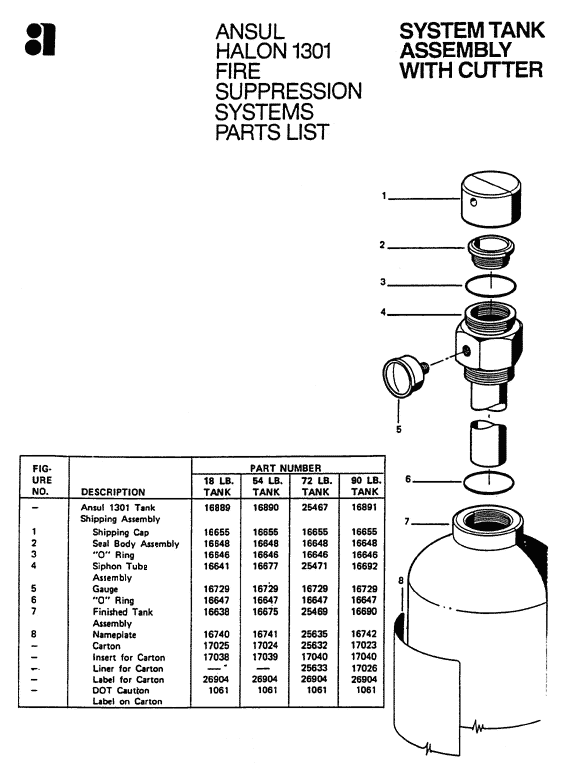
Form No. F-77205
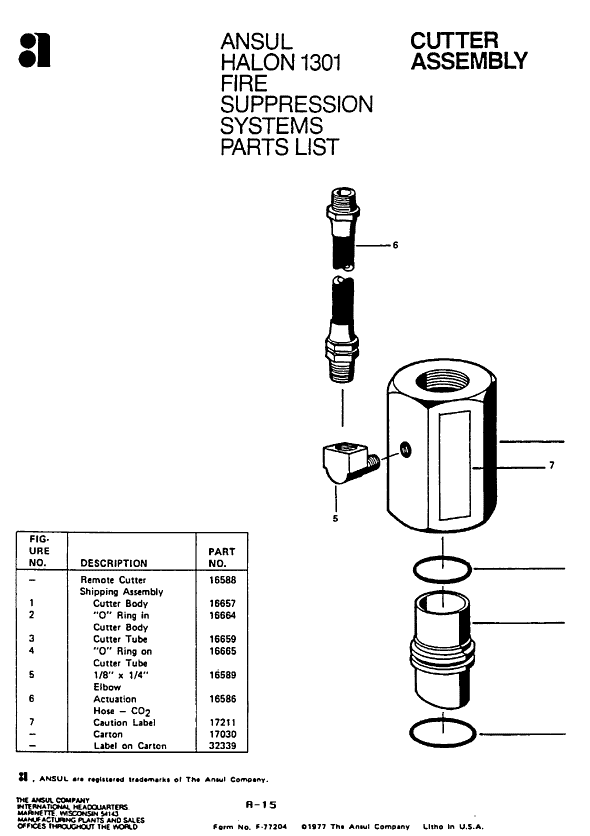
ANSUL/WORMALD - US NAVY VALVE OPERATING PROCEDURES
NAVSEA 0993-LP-031-2010
Table 7-3 Parts List (continued)
|
Figure and |
Part Number |
Description |
Qty Per Assembly | |||
|
7-3 |
27848N (03670) |
VALVE, HALON, 1-1/2 IN. |
| |||
|
-1 |
S27791 (03670) |
|
1 | |||
|
-2 |
S33677 (03670) |
|
1 | |||
|
-3 |
S26711 (03670) |
|
1 | |||
|
-4 |
2367 (03670) |
|
1 | |||
|
-5 |
S27857 (03670) |
|
2 | |||
|
-6 |
S33676 (03670) |
|
1 | |||
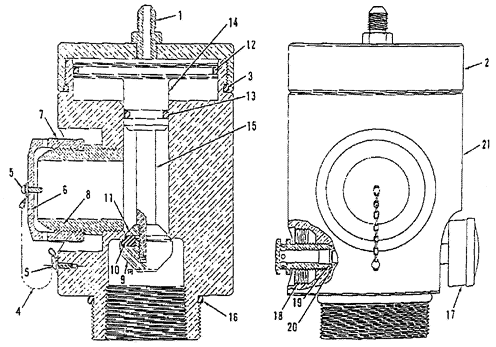
Figure 7-3. 1-1/2-Inch Halon Valve
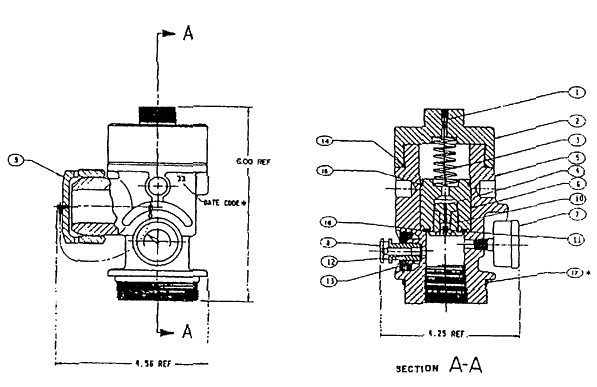
Figure 7-28 Valve Assembly Cylinder1.11 in .. Halon 1301
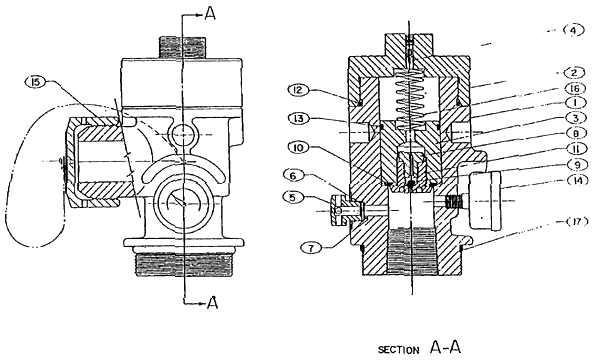
Figure 7-36 Valve Assembly Cylindor, Halon 1301